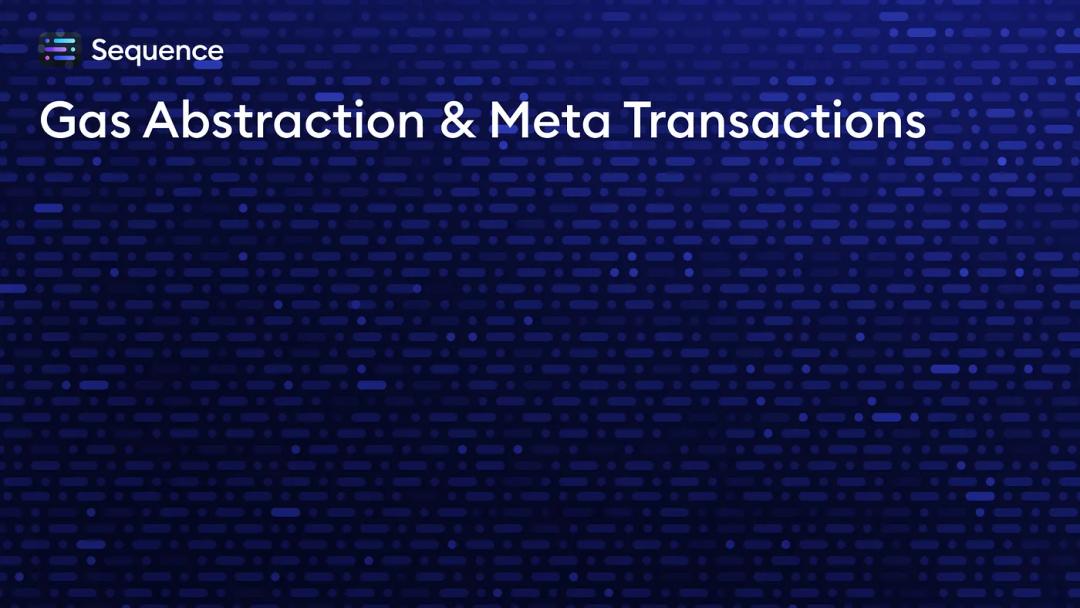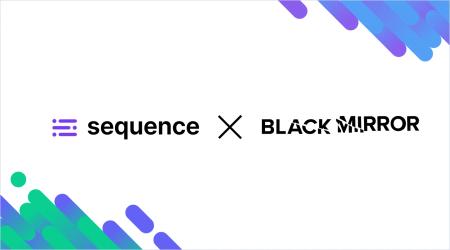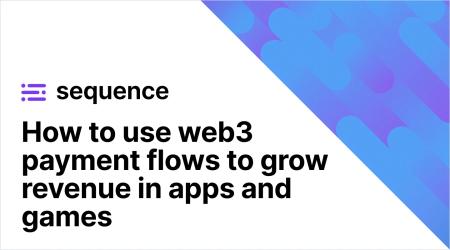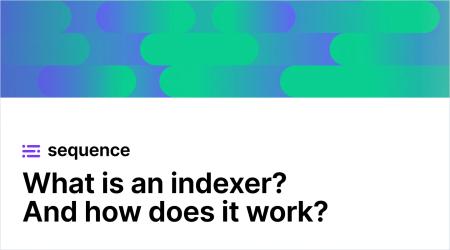Gasless transactions and gas abstraction — how meta transactions work with Sequence
March 8 2023

User experience and user onboarding are significant challenges for developers of decentralized applications. Web3 apps are often criticized for being overly complicated, especially for new users unfamiliar with the technology. Among the issues are expensive gas fees and complex transactions. Meta transactions are an important solution that dramatically improves the user experience to overcome these barriers to adoption.
What are meta transactions?
Traditionally, a blockchain transaction would require the person sending the transaction to pay for gas (which is used to pay for the computing power of the transaction).
Meta transactions allow anyone to interact with the blockchain without holding tokens to pay for transaction fees. This is achieved by separating the transaction's sender from the gas payer. This means that one person is allowed to send a transaction and have the transaction finalized and paid for by a totally separate entity.
A smart contract wallet such as Sequence provides an effective means of implementing meta-transactions. These wallets act as the relayer of a transaction, acting as a trusted forwarder that executes the transaction and covers its gas fees.
Because meta transactions enable a seamless transacting experience for users and provide a lower barrier to entry, they are considered a key prong in the strategy to onboard the next billion users to web3. Think about common web2 experiences — every time someone tweets, Twitter incurs costs for storing that tweet, but users are not charged a per-tweet storage fee. New web3 users have certain expectations of how applications work, and removing the UX risks associated with paying and calculating gas will make web3 more user-friendly and accessible.
The main type of meta transaction is gasless or zero-gas transactions. It sounds like this: someone other than the user pays the gas fees. Another important type of meta transaction is gas abstraction, which allows users to pay gas fees in tokens other than the network’s native token. Sequence supports both of these transaction types, as well as other types of meta-transactions.
How do they work?
A meta transaction is a regular transaction that embeds another transaction within it. The sender of the actual transaction signs their intended action with their private key, and this signed message is passed on to a relayer. The relayer then wraps a second transaction around it, which is sent to the network. Sequence acts as the relayer, allowing developers to sponsor gas for their users.
The standard way to perform this is by having a contract that holds the funds of the user, in effect behaving like a wallet. This contract then validates the signatures it receives and performs arbitrary action based on the provided intent. It will only perform an action if it is signed by the entity it recognizes as its owner, the user controlling the wallet. It does not matter who sends a transaction calling the contract so long as the signature that the contract receives is from its owner.
Good news though: Sequence has simplified this process with its various moving parts, providing a no-code means for developers to implement gasless transactions and gas abstraction.
Gasless transactions
What we have talked about so far are also known as gasless transactions. These are the most common type of meta transaction, meaning that users do not have to pay gas at all. Gasless transactions let your users perform key actions in your app or game without the barriers of having to fund their wallet or pay a fee.
With Sequence, you can whitelist your contracts to pay transaction fees for your users simply by reaching out to us on Discord. We will implement gasless transactions for your smart contract on your behalf.
Gas abstraction
Gas abstraction is another term for relaying the gas of a transaction, but it is generally used to refer to the fact that users can pay for their gas in multiple currencies.
When a user wants to perform a transaction, they send their transaction and the token they want to use for the transaction fee to the relayer provided by Sequence. The relayer then converts the token into the network’s native token, pays the transaction fee on behalf of the user, and sends the transaction to the network.
Users can pay transaction fees using any token supported by the relayer rather than being limited to the network’s native token. This reduces friction for users accessing the network and using decentralized applications, as they are no longer required to hold the network’s native token to perform transactions.
Sequence gas abstraction currently allows users to pay gas in the following tokens:
- ETH & WETH
- MATIC
- USDC
- DAI
Users can automatically use the gas abstraction feature when interacting with the Sequence Wallet. The developer can set tokens to default or switch off tokens when the wallet is instantiated by using flags such as `defaultFundingCurrency` and `lockFundingCurrencyToDefault`. You can find out more in our documentation. And, if you want your users to pay transaction fees with your in-app currency, reach out to us on Discord.
Using meta transactions, the Sequence Relayer solves gas friction and delivers many other features for developers. These features include batch and parallel transactions, optimal gas pricing, and faster transaction delivery. The relayer is compatible with any existing or new Ethereum smart contract.
Get started with meta transactions.
Meta transactions are set to play a major role in web3’s adoption. To get started using gasless transactions and gas abstraction and to learn more about the Sequence Relayer, join our Discord.
Easily build the world’s most user-friendly web3 experiences. Whether it’s games, digital collectibles, loyalty programs, or token-gated communities, Sequence makes innovative web3 experiences accessible to anyone thanks to our user-friendly account-abstraction wallet and modular developer platform.
Feel free to ask us anything — we’d love to chat.
Sequence makes building onchain simple. Developers and teams can launch, grow, and monetize apps with unified wallets, 1-click cross-chain transactions, and real-time data, all in a modular and secure stack. No more stitching together fragmented tools or battling poor user flows. Sequence is production-ready infrastructure that helps teams ship faster, onboard more users, and scale confidently. From chains and stablecoins to DeFi and gaming, Sequence powers developers and applications across the EVM ecosystem with billions in transaction volume and millions of users. Trusted by leaders in blockchain, Sequence powers today’s onchain apps and delivers future-proof infrastructure for tomorrow’s breakthroughs. Learn more at sequence.xyz.
Written by

Robert Guenette
Product Marketing DirectorRelated Posts

A short guide that explains exactly what gasless transactions are, and why they matter for your web3 experience.

In partnership with KOR Protocol, Sequence and Msquared, Black Mirror's franchise has launched the $MIRROR token and a new web3 experience!

Web3 payment flows allow any app to embed onchain purchases and interactions in a way that feels natural for users. Learn more about them!

As more applications and protocols move onchain, indexers redefine how dev teams access, organize, and use blockchain data. Learn how!
